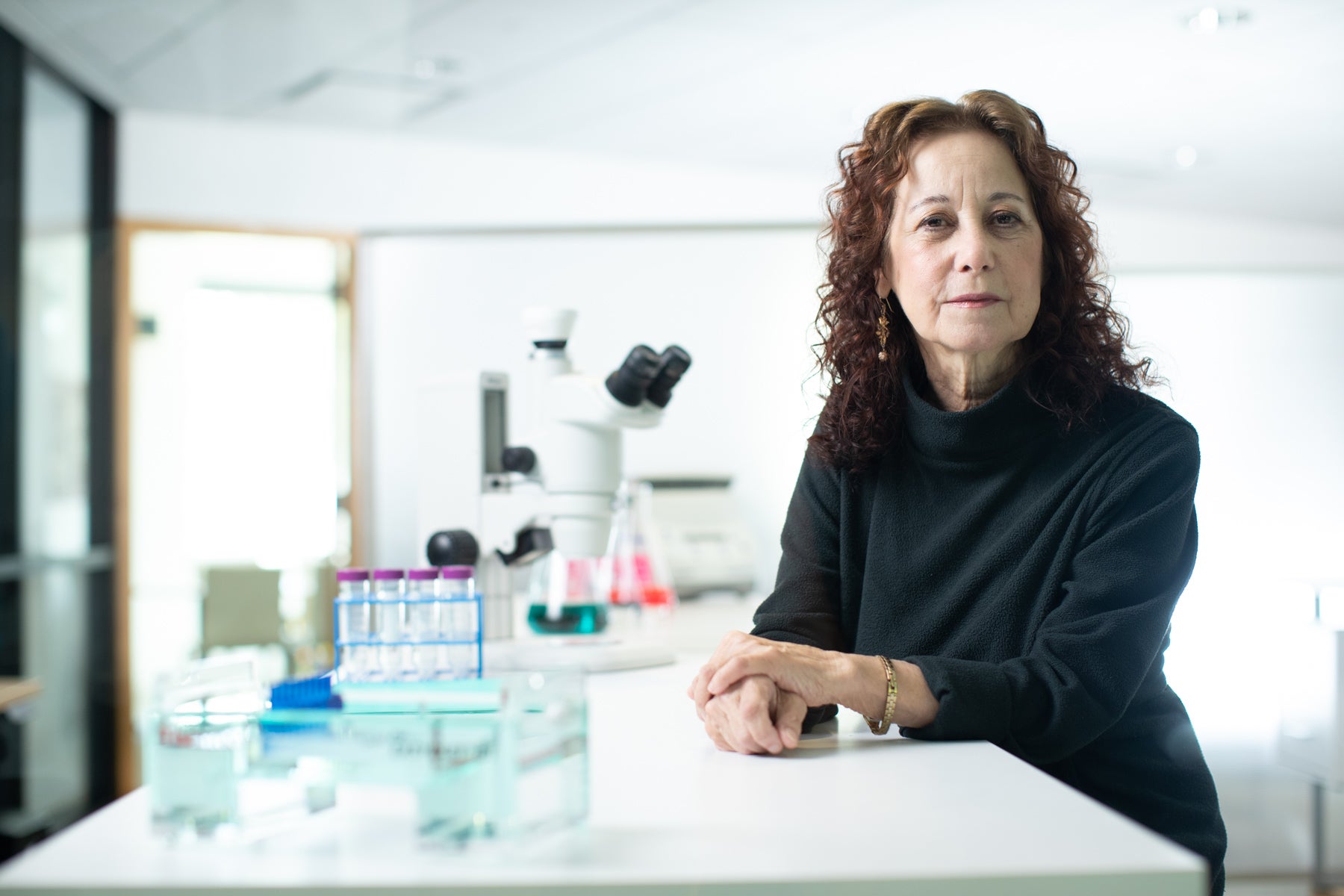A leading scientist on aging says there is no magic pill for staying young—yet
At the second annual Undoing Aging conference in Berlin last month, the who’s who of aging and radical life extension—immortalists, biotech CEOs, venture capitalists, and longevity “insiders” (e.g. doctors, scientists, students, activists, and biohackers)—packed into a cramped, multi-story warehouse that hinted of a previous life as a nightclub.


At the second annual Undoing Aging conference in Berlin last month, the who’s who of aging and radical life extension—immortalists, biotech CEOs, venture capitalists, and longevity “insiders” (e.g. doctors, scientists, students, activists, and biohackers)—packed into a cramped, multi-story warehouse that hinted of a previous life as a nightclub.
The conference focused on the science and business of life extension, but with celebrity immortalist Aubrey de Grey as host, there was a fair amount of talk about living forever.
One overhears a lot at an aging conference, especially when its attendees run the gamut from Harvard academics to radical anti-death warriors (and it serves catering wine at 4:30 pm every day). Words like inflammation and joints were tossed about with as much verve as immortality and snake oil. That said, there was one word that seemed to be tip of tongue for everyone: senolytics, otherwise known as the first drugs designed for the express purpose of fighting aging.
A cocktail of cancer medicines, senolytics target “senescent” cells—what the media often dubs “zombie” cells—that accumulate in the body as we age, causing damage to the well-behaved cells around them. Drugs have long targeted the diseases of aging—cancer, Alzheimers, etc.—but since aging is not considered a disease by the Federal Drug Administration (it’s a “risk factor”), the agency has never approved a drug to combat it. Now senolytics seem to be on the verge of breaking this precedent, thanks largely to a company called Unity Biotechnology, which went public in 2018 and completed its first FDA-approved human trial this year. The company’s success drives much of the hype around senolytics—Unity counts both Jeff Bezos and Peter Thiel amongst its early investors.
But the fanfare around senolytics, as often is the case, seems to have surpassed the science. Senolytics have been lauded as a “wonder drug” and “magic bullet“—even though they have so far only seen success in mice.

For a reality check on the “magic” anti-aging drugs, Quartz sat down with Judith Campisi, a pioneering aging researcher whose lab at the California-based Buck Institute for Research on Aging is known for its work on senescence. Campisi, also a senior scientist at Lawrence Berkeley National Laboratory, is one of the scientific co-founders of Unity Biotechnology.
She’s been in aging research since the early 80s when she completed her postdoc at Harvard Medical School. She laughs when asked about how the aging field has changed since then. “When I was a student, I could not think of anything more boring than to study aging,” she says. “All people were doing is they were grinding up old and young rats and measuring stuff.”
She adds that today, the field is more exciting than ever; whereas academic and government institutions have typically funded aging research, a new wave of longevity-focused venture capital firms have sprung up, bringing more money to the field than has been the case historically. Indeed, it seems that aging is more popular than ever, which makes it an ideal time to have a good look at what’s exaggeration, and what’s the truth.
Can you explain what senescent cells are, and what senolytics do to them?
I work on what happens to cells when they’re damaged or they’re stressed, and how this impacts aging diseases. What we know about these cells is that they’re called senescent cells, and they increase with age. They’re also present at sights of pathology. For example, if you compare the brain of a cognitively normal 90-year-old and a 90-year-old with Alzheimer’s, you’ll find more senescent cells in the brain of the Alzheimer’s patient.
In humans, we would like to think that senescent cells are driving multiple pathologies: osteoarthritis, heart disease, macular degeneration, Alzheimer’s disease, and dementias of all sorts. But we don’t know that. This is where scientists—we are very conservative in what we say—[say that] we don’t know. But in mice we do know. In mice, we can get those senescent cells to die, and those mice are healthier. They don’t live longer in terms of maximum lifespan. They die healthier. So they have less period of disability.
The first senolytic drugs are now in people, phase one is over, it seems to be okay (meaning nobody was hurt). It’s just a safety trial. And now phase two is underway.
Is it true that senescent cells turn into “zombie cells” and destroy everything around them?
No, no! They’re not zombies. I’ll give you three clear examples of where senescent cells are beneficial. The first is in the embryo. There are certain structures in the embryo that are initiated by a wave of senescent cells. They participate in embryonic development.
The second is parturition—when women and mice go into labor—it’s preceded by a wave of senescence in the placenta…Those senescent cells make a number of molecules that initiate the contraction of the uterus. So it helps deliver the baby. So we need that.
The other is in wound-healing. When you cut yourself, there’s a wave of senescent cells at the wound. And if you eliminate those senescent cells, again, we do this in mice, then the wound takes much longer to heal and it doesn’t heal as well. You get more scarring.
Where did this terrible zombie narrative come from?
I hate that term!
That’s all you find on the internet.
Exactly. So, it’s a balancing act, right? It’s the good stuff and the bad stuff. And the challenge is to keep this and get rid of that. And that’s why with senolytics. It’s not going to be simple. It’s not simple.
I think what frustrates me a little bit—this doesn’t frustrate me with laypeople because they just don’t have the background—but it frustrates me with scientists, when they ignore what we know about biology, which is that it’s complicated and we’ve been optimized to live healthy for 30 or 40 years. And that means that whenever you mess with something, you have to worry about what you’re upsetting.
And sometimes it’s worth it. If you are type-two diabetic, you do want to take metformin, but metformin is not a drug with no costs. There are also costs. So scientists should know better, know there’s no magic pill. If there were we would have found it already.
What do you think the prospects are for these drugs?
I think it’s very good. And I’ll tell you why. They’re going into the knee of osteoarthritic people, and [my lab] collaborated with Unity and a woman named Jennifer Ellison, a bioengineer who is very interested in joints and how joints are fit together.
What she did was collaborate with surgeons who were taking—when people have knee replacement surgery—they take that whole damaged joint out. She had access to that human tissue.
Then she could add drugs to that human tissue and show one, that senescent cells did die. And two that, when you clear senescent cells from those joints, you change the tissue environment so that the stem cells in the joint are better able to start rejuvenating.
And so you actually start building a better joint. So I’m very optimistic about that drug in osteoarthritic patients. Now whether it’s going to do the same for heart disease or cancer remains to be seen.
Do you think that’s what investors are going for?
Yes, of course. Although osteoarthritis is a huge problem, it doesn’t kill you. But it sure makes your life miserable. And so there’s a huge market. I mean that’s what investors care about, the market. If Unity is successful with osteoarthritis, they’re going to make money. Your investors will be there.
Is it frustrating for you then when the investors come in and say that senolytics are the next big thing?
I’m not saying that they won’t help, they will, I’m just saying it’s not going to be as simple as you take your senolytic, you know, every six months and everything will be fine.
If you’re pregnant, you’re not going to take a senolytic, if you’re having surgery, you’re not going to take a senolytic.
What do you think our prospects are for living longer, healthier lives in the next 10 years? In the next 50 years?
I think it’s quite good. I do.
How many years?
Well, I mean of course it’s hard to predict the future, right? I mean, ask me what the stock market will do tomorrow. I can give you an answer, and if you believe me you’re crazy.
I really think if Unity doesn’t screw up, or if the drug doesn’t have some side effect we don’t know about—which is always possible—I think it’s going to make a huge difference in quality of life for people who are suffering from osteoarthritis. Right now it’s knees, but there’s hands and shoulders, so that’s one, and then there are these other diseases. The next thing they’re going to tackle are diseases of the eye.
Is it challenging to be in this environment where a lot of people, their primary goal is the defeat of death?
It’s not challenging. I don’t argue with the sentiment. If you are healthy, you’re in great shape, you’re on the tennis court, and you’re winning, and oops! you’re 122—it’s time for you to die—that’s a tragedy. But now there’s no basis to believe that this is a solvable problem. Whereas I think aging, the decline in health, and the decline in quality of life, I think we are on the cusp of that.
I’m not optimistic that we will, in a couple of decades, defeat death. But I am optimistic make great strides in aging.